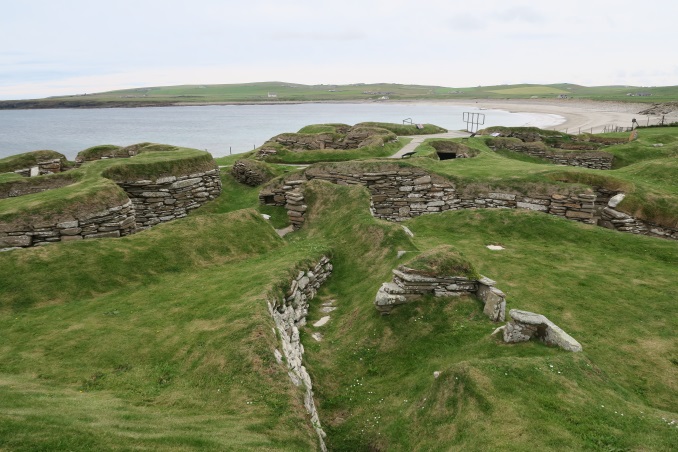
Orkney (Scottish Gaelic: Arcaibh), is an archipelago made up of 70 islands, 20 of which are inhabited, that lie 10 miles (16 km) from the coast of Caithness (Scottish Gaelic: Gallaibh) in northern Scotland.
During the winter of 1850 a severe storm lashed the islands including the largest island in the group called Mainland. Beneath the sand dunes on the Bay of Skaill the combination of wind and some very high tides stripped the grass from a large mound, then known as "Skerrabra" and revealed a long hidden secret. One of the most remarkable archaeological sites in the world was discovered that year, when after many centuries nature lifted the cloak that had covered the 5000 year old preserved village at Skara Brae. Local laird, William Watt of Skaill, began an excavation of the site in 1868. Four ancient houses were unearthed before work at Skerrabra was abandoned. The settlement remained undisturbed until 1925 when a further storm was seen to threaten the site and a sea-wall was built to preserve the remains. Construction of this led to the discovery of more ancient buildings.
Between 1928 and 1930 further excavations uncovered the dwellings visible today. Subsequent radiocarbon dating point to the village having been occupied for about 600 years from 3100 BC to 2500 BC. This was a time in the Neolithic or New Stone Age period before the discovery of metal. Eight dwellings can be seen, linked together by a series of low, covered passages. The buildings, along with their contents, are well-preserved, with the walls of the structures still standing, and alleyways roofed by their original stone slabs. Tools, furniture and artwork found on the site give clues of how the ancient inhabitants lived their lives. Due to coastal erosion, Skara Brae now stands right by the shore of the Bay o' Skaill. However, during its lifetime the village would have been some distance from the sea. Over time the encroaching sand dunes led to the village’s gradual abandonment.